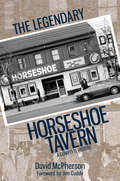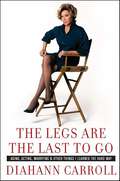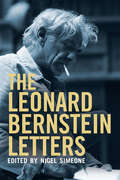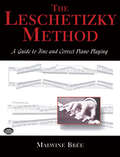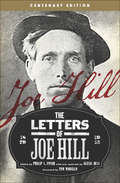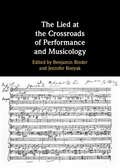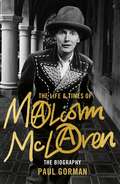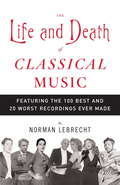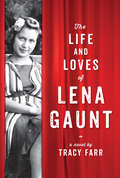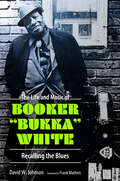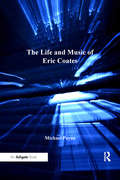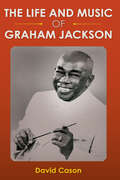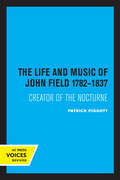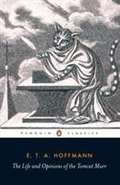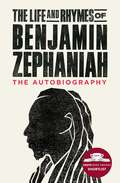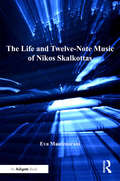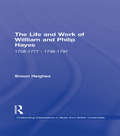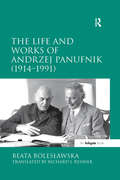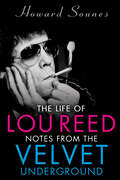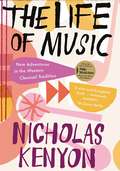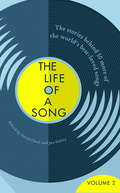- Table View
- List View
The Legendary Horseshoe Tavern: A Complete History
by David Mcpherson Jim CuddyA complete history of Toronto’s legendary Horseshoe Tavern, “the Birthplace of Canadian Rock,” to coincide with its seventieth anniversary. Like the Queen Street strip that has been its home for seven decades, the Horseshoe Tavern continues to evolve. It remains as relevant today as it did when Jack Starr founded the country music club on the site of a former blacksmith shop. From country and rockabilly to rock ‘n’ roll, punk, alt/country, and back to roots music, the venerable live music venue has evolved with the times and trends — always keeping pace with the music. Over its long history, the Horseshoe has seen a flood of talent pass through. From Willie Nelson to Loretta Lynn, Stompin’ Tom Connors to The Band, and Bryan Adams to the Tragically Hip, the Horseshoe has attracted premier acts from all eras of music. In The Legendary Horseshoe Tavern, David McPherson captures the turbulent life of the bar, and of Canadian rock.
The Legs Are the Last to Go: Aging, Acting, Marrying, & Other Things I Learned the Hard Way
by Diahann CarrollIt's conventional wisdom that Hollywood has no use for a woman over forty. So it's a good thing that Diahann Carroll—whose winning, sometimes controversial career breached racial barriers—is anything but conventional.Here she shares her life story with an admirable candidness of someone who has seen and done it all. With wisdom that only aging gracefully can bestow, she talks frankly about her four marriages as well as the other significant relationships in her life, including her courtship with Sidney Poitier; racial politics in Hollywood and on Broadway; and the personal cost, particularly to her family, of being a pioneer. Carroll's storied history, blunt views, and notorious wit will be sure to entertain and inform.
The Leonard Bernstein Letters
by Leonard Bernstein&“With their intellectual brilliance, humor and wonderful eye for detail, Leonard Bernstein&’s letters blow all biographies out of the water.&”—The Economist (2013 Book of the Year) Leonard Bernstein was a charismatic and versatile musician—a brilliant conductor who attained international superstar status, and a gifted composer of Broadway musicals (West Side Story), symphonies (Age of Anxiety), choral works (Chichester Psalms), film scores (On the Waterfront), and much more. Bernstein was also an enthusiastic letter writer, and this book is the first to present a wide-ranging selection of his correspondence. The letters have been selected for the insights they offer into the passions of his life—musical and personal—and the extravagant scope of his musical and extra-musical activities. Bernstein&’s letters tell much about this complex man, his collaborators, his mentors, and others close to him. His galaxy of correspondents encompassed, among others, Aaron Copland, Stephen Sondheim, Jerome Robbins, Thornton Wilder, Boris Pasternak, Bette Davis, Adolph Green, Jacqueline Kennedy Onassis, and family members including his wife Felicia and his sister Shirley. The majority of these letters have never been published before. They have been carefully chosen to demonstrate the breadth of Bernstein&’s musical interests, his constant struggle to find the time to compose, his turbulent and complex sexuality, his political activities, and his endless capacity for hard work. Beyond all this, these writings provide a glimpse of the man behind the legends: his humanity, warmth, volatility, intellectual brilliance, wonderful eye for descriptive detail, and humor. &“The correspondence from and to the remarkable conductor is full of pleasure and insights.&”—The New York Times Book Review (Editors&’ Choice) &“Exhaustive, thrilling [and] indispensable.&”—USA Today (starred review)
The Leschetizky Method: A Guide to Fine and Correct Piano Playing (Dover Books on Music)
by Malwine BréeBorn in Poland in 1830, Theodor Leschetizky was a pianist, teacher, and composer. Although he toured widely as both a player and conductor, and composed two operas and a number of piano pieces, it was as a teacher that he achieved his greatest renown. A pupil himself of the great Carl Czerny, Leschetizky went on to instruct an entire generation of world-class pianists, including Paderewski, Schnabel, Moiseiwitsch, Brailowsky, and many others.In this legendary, hard-to-find book, his pupil and assistant Malwine Brée recorded the principles and techniques of the "Leschetizky Method" of piano instruction. Approved by Leschetizky himself, the clear, easy-to-follow text, profusely illustrated with music examples and photographs of hand positions (Leschetizky's own hands), covers every aspect of piano technique: finger exercises, scales, octaves, chords, arpeggios, the glissando, embellishments, dynamics, the pedal, and many other topics. Also included here is a fascinating article, "Practical Hints on Piano Study" by Ignace J. Paderewski, along with other articles on hand and finger exercises, other piano methods, and more. Any student and teacher of piano will want to have this classic instruction manual, difficult to locate in the past, but now available in this attractive, inexpensive edition.
The Letters of Cole Porter
by Cole PorterThe first comprehensive collection of the letters of one of the most successful American songwriters of the twentieth century From Anything Goes to Kiss Me, Kate, Cole Porter left a lasting legacy of iconic songs including "You're the Top," "Love For Sale," and "Night and Day." Yet, alongside his professional success, Porter led an eclectic personal life which featured exuberant parties, scandalous affairs, and chronic health problems. This extensive collection of letters (most of which are published here for the first time) dates from the first decade of the twentieth century to the early 1960s and features correspondence with stars such as Irving Berlin, Ethel Merman, and Orson Welles, as well as his friends and lovers. Cliff Eisen and Dominic McHugh complement these letters with lively commentaries that draw together the loose threads of Porter&’s life and highlight the distinctions between Porter&’s public and private existence. This book reveals surprising insights into his attitudes toward Hollywood and Broadway, and toward money, love, and dazzling success.
The Letters of Joe Hill: Centenary Edition
by Joe HillThe legendary songwriter and labor rights activist reveals his personal struggles and political philosophy in this collection of letters.As a proud member of the Industrial Workers of the World, Joe Hill dedicated his life to the union cause. The original bard of the working class, he spread a message of solidarity and struggle through unforgettable, bitingly satirical songs. But after a suspicious arrest and controversial trial, Hill was convicted of murder in 1914. A year later, he was put to death by the capitalist state.In this collection of letters, many of which were written from prison in Salt Lake City, readers get to know the man behind the legendary songs. Hill corresponds with friends and fellow workers, discussing his case, his life, his music, and cheering on the Wobblies even as he faces death.“Joe Hill's influence is everywhere. Without Joe Hill, there's no Woody Guthrie, no Dylan, no Springsteen, no Clash, no Public Enemy, no Minor Threat, no System of a Down, no Rage Against the Machine.” —Tom Morello, from the foreword
The Lied at the Crossroads of Performance and Musicology
by Jennifer Ronyak Benjamin BinderThere seems to be an essential relationship between the performance and the scholarship of the German Lied. Yet the process by which scholarly inquiry and performative practices mutually benefit one another can appear mysterious and undefined, in part because any dialogue between the two invariably unfolds in relatively informal environments – such as the rehearsal studio, seminar room or conference workshop. Contributions from leading musicologists and prominent Lied performers here build on and deepen these interactions to reconsider topics including Werktreue aesthetics and concert practices; the authority of the composer versus the performer; the value of lesser-known, incomplete, or compositionally modified songs; and the traditions, habits and prejudices of song recitalists regarding issues like transposition, programming and dramatic modes of presentation. The book as a whole reveals the reciprocal relevance of Lied musicology and Lied performance, thereby opening doors to fresh and exciting modes of interpretative artistry and intellectual discovery.
The Life & Times of Malcolm McLaren: The Biography
by Paul Gorman'I couldn't put this book down. Malcolm inspired us to make art out of our boredom and anger. He set us free' Bobby Gillespie, Primal ScreamIncluded in the Guardian 10 best music biographies'Excellent . . . With this book, Gorman convincingly moves away from the ossified image of McLaren as a great rock'n'roll swindler, a morally bankrupt punk Mephistopheles, and closer towards his art-school roots, his love of ideas. Tiresome, unpleasant, even cruel - he was, this book underlines, never boring' Sunday Times'Exhaustive . . . compelling' Observer'Definitive . . . epic' The Times'Gobsmacker of a biography' Telegraph'This masterful and painstaking biography opens its doorway to an era of fluorescent disenchantment and outlandish possibility' Alan MooreMalcolm McLaren was one of the most culturally significant but misunderstood figures of the modern era. Ten years after his life was cruelly cut short by cancer, The Life & Times of Malcolm McLaren sheds fascinating new light on the public achievements and private life of this cultural iconoclast and architect of punk, whose championing of street culture movements including hip-hop and Voguing reverberates to this day. With exclusive contributions from friends and intimates and access to private papers and family documents, this biography uncovers the true story behind this complicated figure.McLaren first achieved public prominence as a rebellious art student by making the news in 1966 after being arrested for burning the US flag in front of the American Embassy in London. He maintained this incendiary reputation by fast-tracking vanguard and left-field ideas to the centre of the media glare, via his creation and stewardship of the Sex Pistols and work with Adam Ant, Boy George and Bow Wow Wow. Meanwhile McLaren's ground-breaking design partnership with Vivienne Westwood and his creation of their visionary series of boutiques in the 1970s and early '80s sent shockwaves through the fashion industry.The Life & Times of Malcolm McLaren also essays McLaren's exasperating Hollywood years when he broke bread with the likes of Steven Spielberg though his slate of projects, which included the controversial Heavy Metal Surf Nazis and Wilde West, in which Oscar Wilde introduced rock'n'roll to the American mid-west in the 1880s, proved too rich for the play-it-safe film business.With a preface by Alan Moore, who collaborated with McLaren on the unrealised film project Fashion Beast, and an essay by Lou Stoppard casting a twenty-first-century perspective over his achievements, The Life & Times Of Malcolm McLaren is the explosive and definitive account of the man dubbed by Melvyn Bragg 'the Diaghilev of punk'.
The Life & Times of Malcolm McLaren: The Biography
by Paul Gorman'I couldn't put this book down. Malcolm inspired us to make art out of our boredom and anger. He set us free' Bobby Gillespie, Primal ScreamIncluded in the Guardian 10 best music biographies'Excellent . . . With this book, Gorman convincingly moves away from the ossified image of McLaren as a great rock'n'roll swindler, a morally bankrupt punk Mephistopheles, and closer towards his art-school roots, his love of ideas. Tiresome, unpleasant, even cruel - he was, this book underlines, never boring' Sunday Times'Exhaustive . . . compelling' Observer'Definitive . . . epic' The Times'Gobsmacker of a biography' Telegraph'This masterful and painstaking biography opens its doorway to an era of fluorescent disenchantment and outlandish possibility' Alan MooreMalcolm McLaren was one of the most culturally significant but misunderstood figures of the modern era. Ten years after his life was cruelly cut short by cancer, The Life & Times of Malcolm McLaren sheds fascinating new light on the public achievements and private life of this cultural iconoclast and architect of punk, whose championing of street culture movements including hip-hop and Voguing reverberates to this day. With exclusive contributions from friends and intimates and access to private papers and family documents, this biography uncovers the true story behind this complicated figure.McLaren first achieved public prominence as a rebellious art student by making the news in 1966 after being arrested for burning the US flag in front of the American Embassy in London. He maintained this incendiary reputation by fast-tracking vanguard and left-field ideas to the centre of the media glare, via his creation and stewardship of the Sex Pistols and work with Adam Ant, Boy George and Bow Wow Wow. Meanwhile McLaren's ground-breaking design partnership with Vivienne Westwood and his creation of their visionary series of boutiques in the 1970s and early '80s sent shockwaves through the fashion industry.The Life & Times of Malcolm McLaren also essays McLaren's exasperating Hollywood years when he broke bread with the likes of Steven Spielberg though his slate of projects, which included the controversial Heavy Metal Surf Nazis and Wilde West, in which Oscar Wilde introduced rock'n'roll to the American mid-west in the 1880s, proved too rich for the play-it-safe film business.With a preface by Alan Moore, who collaborated with McLaren on the unrealised film project Fashion Beast, and an essay by Lou Stoppard casting a twenty-first-century perspective over his achievements, The Life & Times Of Malcolm McLaren is the explosive and definitive account of the man dubbed by Melvyn Bragg 'the Diaghilev of punk'.
The Life and Death of Classical Music
by Norman LebrechtIn this compulsively readable, fascinating, and provocative guide to classical music, Norman Lebrecht, one of the world's most widely read cultural commentators tells the story of the rise of the classical recording industry from Caruso's first notes to the heyday of Bernstein, Glenn Gould, Callas, and von Karajan. Lebrecht compellingly demonstrates that classical recording has reached its end point-but this is not simply an expos? of decline and fall. It is, for the first time, the full story of a minor art form, analyzing the cultural revolution wrought by Schnabel, Toscanini, Callas, Rattle, the Three Tenors, and Charlotte Church. It is the story of how stars were made and broken by the record business; how a war criminal conspired with a concentration-camp victim to create a record empire; and how advancing technology, boardroom wars, public credulity and unscrupulous exploitation shaped the musical backdrop to our modern lives. The book ends with a suitable shrine to classical recording: the author's critical selection of the 100 most important recordings-and the 20 most appalling.Filled with memorable incidents and unforgettable personalities-from Goddard Lieberson, legendary head of CBS Masterworks who signed his letters as God; to Georg Solti, who turned the Chicago Symphony into " the loudest symphony on earth"-this is at once the captivating story of the life and death of classical recording and an opinioned, insider's guide to appreciating the genre, now and for years to come.From the Trade Paperback edition.
The Life and Loves of Lena Gaunt: A Novel
by Tracy FarrRecounting the remarkable life of Dame Lena Gaunt—music’s most modern musician as the first theremin player of the 20th century—this novel about an octogenarian and former junkie is as geographically diverse as it is culturally and musically rich. An offer to play her unusual instrument, where sounds are produced not through touch but instead through hand movements in the air, leads Lena to revisit her life—from her discovery of music to falling in love and from Southeast Asia to Australia and Europe. Vignettes of growing up, the glittering years on the world stage, melancholy, war-time periods, and growing old all compose the story of a woman whose life is made and torn apart by those she gives her heart to.
The Life and Music of Booker "Bukka" White: Recalling the Blues (American Made Music Series)
by David W. JohnsonBooker “Bukka” White (1905–1977) was one of the most important blues musicians of the twentieth century. The twelve songs he recorded in Chicago in 1940 are considered to be among the finest in country blues. In The Life and Music of Booker “Bukka” White: Recalling the Blues, David W. Johnson traces the trajectory of White’s life from his early years in Chickasaw and Grenada Counties, Mississippi, through his imprisonment in the notorious Mississippi State Penal Farm in the late 1930s, to making a new life for himself in Memphis, Tennessee. For years only a name on old 78 records—and believed by some to be dead—White was “rediscovered” by John Fahey and ED Denson in the summer of 1963. He went on to have a productive second career, playing venues and festivals throughout the United States and in Canada, and touring Europe and Great Britain with the American Folk Blues Festival. In 1975, he was invited to Bremen, Germany, for a solo concert that was released as his final album. In July 1976, the author interviewed White shortly before his discharge from a Massachusetts hospital where he was recovering from a stroke. After spending eight days in the intensive care unit and three weeks in rehabilitation, White was ready to talk about his life. Recalling stories of “slavery time,” White told the author, “. . . some of the [formerly enslaved] guys were wise enough to hold that in their head where they could tell a young pants, where it would go down in history, you know. Just like you doing that now—something happen to you, somebody else will carry that on.” The product of years of research, The Life and Music of Booker “Bukka” White is the first full-length biography of this remarkable country blues performer. Interviewing those who knew White, including his second cousin B. B. King, Johnson has written a detailed and sometimes surprising account of how a young Black man born in the first decade of the twentieth century—the grandson of a slave—found a way to rise above his circumstances and maintain a decades-long career as a musician.
The Life and Music of Eric Coates
by Michael PayneEric Coates (1886-1957) is perhaps the most familiar name associated with British light music. Sir Charles Groves said that 'his music crackled with enthusiasm and vitality. He could write tunes and clothe them in the most attractive musical colours'. Coates won a scholarship to the Royal Academy of Music, and from 1912 to 1919 he was principal viola of the Queen's Hall Orchestra under Sir Henry Wood. He also played under such conductors as Elgar, Delius, Richard Strauss, Debussy, and Beecham. It was, however, as a composer of orchestral music that he found his greatest success. Beginning with the Miniature Suite, written for the 1911 Promenade Concerts, he forged an enviable reputation as a composer. By the 1920s and 1930s, he was one of the most popular and highest-paid British composers, with a string of popular works flowing from his pen. Coates' music has become indelibly entwined with such popular radio programmes as the BBC's In Town Tonight, which was introduced by the 'Knightsbridge' March and Desert Island Discs whose signature tune for the past forty years has been By the Sleepy Lagoon. Perhaps his most memorable work was his march for the Dam Busters film. Michael Payne traces the changing fortunes of the career of the man who composed some of Britain's best-known music. In many ways, Coates' story is the story of British light music, and Payne's study offers a fascinating insight into the heyday and decline of the British light music tradition.
The Life and Music of Graham Jackson
by David CasonA groundbreaking Black artist and his career in the Jim Crow South This book is the first biography of Graham Jackson (1903-1983), a virtuosic musician whose life story displays the complexities of being a Black professional in the segregated South. David Cason discusses how Jackson navigated a web of racial and social negotiations throughout his long career and highlights his little-known role in events of the twentieth century. Widely known for an iconic photo taken of him playing the accordion in tears at Franklin D. Roosevelt’s funeral, which became a Life magazine cover, Jackson is revealed here to have a much deeper story. He was a performer, composer, and high school music director known for his skills on the piano and organ. Jackson was among the first Black men to enlist in the Navy during World War II, helping recruit many other volunteers and raising over $2 million for the war effort. After the war he became a fixture at Atlanta music venues and in 1971, Governor Jimmy Carter proclaimed Jackson the State Musician of Georgia.Cason examines Jackson’s groundbreaking roles with a critical eye, taking into account how Jackson drew on his connections with white elites including Roosevelt, Coca-Cola magnate Robert Woodruff, and golfer Bobby Jones, and was censured by Black Power figures for playing songs associated with Confederate memory. Based on archival, newspaper, and interview materials, The Life and Music of Graham Jackson brings into view the previously unknown story of an ambitious and talented artist and his controversial approach to the politics and culture of his day. Publication of this work made possible by a Sustaining the Humanities through the American Rescue Plan grant from the National Endowment for the Humanities.
The Life and Music of John Field 1782-1837: Creator of the Nocturne
by Patrick PiggottThis title is part of UC Press's Voices Revived program, which commemorates University of California Press’s mission to seek out and cultivate the brightest minds and give them voice, reach, and impact. Drawing on a backlist dating to 1893, Voices Revived makes high-quality, peer-reviewed scholarship accessible once again using print-on-demand technology. This title was originally published in 1973.
The Life and Music of Oliver Mtukudzi: Reconstruction and Identity
by Ezra Chitando Pauline Mateveke Munyaradzi Nyakudya Bridget ChinouririThis book is a critical reflection on the life and career of the late legendary Zimbabwean music icon, Oliver “Tuku” Mtukudzi, and his contribution towards the reconstruction of Zimbabwe, Africa and the globe at large. Mtukudzi was a musician, philosopher, and human rights activist who espoused the agenda of reconstruction in order to bring about a better world, proposing personal, cultural, political, religious and global reconstruction. With twenty original chapters, this vibrant volume examines various themes and dimensions of Mtukudzi’s distinguished life and career, notably, how his music has been a powerful vehicle for societal reconstruction and cultural rejuvenation, specifically speaking to issues of culture, human rights, governance, peacebuilding, religion and identity, humanism, gender and politics, among others. The contributors explore the art of performance in Mtukudzi’s music and acting career, and how this facilitated his reconstruction agenda, offering fresh and compelling perspectives into the role of performing artists and cultural workers such as Mtukudzi in presenting models for reconstructing the world.
The Life and Opinions of the Tomcat Murr (Penguin Classics)
by E. T. A. HoffmanTomcat Murr is a loveable, self-taught animal who has written his own autobiography. But a printer's error causes his story to be accidentally mixed and spliced with a book about the composer Johannes Kreisler. As the two versions break off and alternate at dramatic moments, two wildly different characters emerge from the confusion - Murr, the confident scholar, lover, carouser and brawler, and the moody, hypochondriac genius Kreisler. In his exuberant and bizarre novel, Hoffmann brilliantly evokes the fantastic, the ridiculous and the sublime within the humdrum bustle of daily life, making The Life and Opinions of the Tomcat Murr (1820-22) one of the funniest and strangest novels of the nineteenth century.
The Life and Rhymes of Benjamin Zephaniah: The Autobiography
by Benjamin Zephaniah*BBC Radio 4 Book of the Week* Benjamin Zephaniah, who has travelled the world for his art and his humanitarianism, now tells the one story that encompasses it all: the story of his life. In the early 1980s when punks and Rastas were on the streets protesting about unemployment, homelessness and the National Front, Benjamin&’s poetry could be heard at demonstrations, outside police stations and on the dance floor. His mission was to take poetry everywhere, and to popularise it by reaching people who didn&’t read books. His poetry was political, musical, radical and relevant. By the early 1990s, Benjamin had performed on every continent in the world (a feat which he achieved in only one year) and he hasn&’t stopped performing and touring since. Nelson Mandela, after hearing Benjamin&’s tribute to him while he was in prison, requested an introduction to the poet that grew into a lifelong relationship, inspiring Benjamin&’s work with children in South Africa. Benjamin would also go on to be the first artist to record with The Wailers after the death of Bob Marley in a musical tribute to Nelson Mandela.The Life and Rhymes of Benjamin Zephaniah is a truly extraordinary life story which celebrates the power of poetry and the importance of pushing boundaries with the arts.
The Life and Twelve-Note Music of Nikos Skalkottas: A Study Of His Life And Twelve-note Compositional Technique
by Eva MantzouraniNikos Skalkottas is perhaps the last great 'undiscovered' composer of the twentieth century. In the 1920s he was a promising young violinist and composer in Berlin, and a student of Schoenberg, who included him among his most gifted pupils. It was only after his return to Greece in 1933 that Skalkottas became an anonymous and obscure figure, working in complete isolation until his death in 1949. Most of his works remained unpublished and unperformed during his lifetime, and although he is largely known for his folkloristic tonal pieces, Skalkottas in fact concentrated predominantly on developing an idiosyncratic dodecaphonic musical language. Eva Mantzourani provides here a comprehensive study of this fascinating yet under-researched composer. The book, lavishly illustrated with musical examples, is divided into three parts. Part I comprises a critical biography that, by drawing extensively on his letters and other writings, reappraises the image of Skalkottas with which we are often presented. The main focus of the book, however, is on Skalkottas's twelve-note compositional processes, since these characterize the majority of his output, and are neither well-known nor fully understood. Part II presents the structural and technical features of his twelve-note technique, particularly the different types of sets and their manipulation, and his approach to musical forms. Part III consists of analytical case studies of several works, presented chronologically, which thus provide a diachronic framework within which Skalkottas's dodecaphonic compositional development can be more effectively viewed. This book underlines Nikos Skalkottas's importance as a composer with a distinctive artistic personality, whose work contributed to the development of twelve-note compositional practice, and who deserves a more significant position within the Western art music canon than that to which he is often assigned.
The Life and Work of William and Philip Hayes: 1708-1777--1738-1797 (Outstanding Dissertations in Music from British Universities)
by Simon HeighesFirst Published in 1996. William and Philip Hayes, father and son, between them occupied the Heather Chair of Music at the University of Oxford for over half a century (1741-97). Although they lived and worked largely outside the mainstream of London's cosmopolitan musical life, their outlook was surprisingly broad. The present study reveals them to have been two of the most important provincial musicians of their age, who as composers contributed to all the main genres of the time except opera.
The Life and Works of Andrzej Panufnik (1914-1991)
by Beata Boles?awskaSir Andrzej Panufnik was born in Warsaw and studied in the newly independent Poland in the 1930s, as well as in Vienna and Paris just before the outbreak of the Second World War. During the German occupation he formed a piano duo with his friend and fellow composer Witold Lutoslawski, and they performed in caf�around Warsaw. After the war, Panufnik quickly established himself as a leading Polish composer, and as a conductor he played a significant role in the re-establishment of first the Krak�nd then the Warsaw Philharmonic. Although he was considered Poland�s leading composer for some years after the war, Panufnik was subsequently put under intolerable pressure both musically and politically. Frustrated by the continuing rejection of his compositions and the unending political demands inflicted on him by the country�s post-war Communist regime, he made a daring escape to England in 1954. He briefly became Principal Conductor of the City of Birmingham Symphony Orchestra, a post he relinquished after two years to devote all his time to composition. His works were in demand by major figures such as Leopold Stokowski who conducted the first performances of Sinfonia Elegiaca, Katyn Epitaph and Universal Prayer, Yehudi Menuhin who commissioned the Violin Concerto, Seiji Ozawa in Boston and Sir Georg Solti in Chicago who both commissioned symphonies for the centenaries of their famous orchestras; also Mstislav Rostropovich with the London Symphony Orchestra, who together commissioned the Cello Concerto. Beata Boleslawska has written the first book on the life and artistic output of Panufnik, setting his significance alongside the political and cultural scene of twentieth-century Europe. The account of the composer�s life is based on numerous archival documents, as well as the personal accounts contributed by his family and friends. Panufnik�s compositional style and techniques are also analysed. This book will be of interest not only to those devoted
The Life of Lou Reed: Notes from the Velvet Underground
by Howard SounesAn illuminating biography of Lou Reed, featuring interviews with over 140 people who knew him intimately, plus previously unpublished photographs. As band leader of the Velvet Underground and later a successful solo artist, Reed was much more than what the general public came to know as the grumpy New Yorker in black who sang &“Walk on the Wild Side.&” To his dedicated admirers, he was one of the most innovative and intelligent songwriters of modern times—a natural outsider who lived a tumultuous and tortured life. In the course of his deep research into Reed&’s life, from a humble upbringing on Long Island to death from liver disease in 2013, Howard Sounes interviewed more than 140 people who knew the artist intimately—some of whom have not spoken publicly about him before. With new revelations from former wives and lovers, family members, fellow band members and celebrities, and music industry figures, this book offers an updated, unfettered look at Reed&’s creative process, his mental health problems, his bisexuality, his three marriages, and his addictions to drugs and alcohol. Featuring previously unpublished photographs of some of Reed&’s most private moments, this is the definitive account of one of rock &’n&’ roll&’s most complicated and brilliant prophets. &“Compelling . . . Sounes takes pride in carefully debunking the myths that have crept in from Reed&’s own fictionalizations.&” —The Sunday Telegraph &“Controversial . . . Sounes&’ book pushes the standard Reed narrative.&” —New York Times &“A measured chronicle of the life and music of Lou Reed . . . Sounes proves to be an amiable narrator who successfully reveals Reed as an innovative, influential musician.&” —Publishers Weekly &“A walk on the dark side.&” —Independent &“A must read . . . Sounes chronicles Reed&’s turbulent, and often brutal, relationships with men and women . . . and the wayward talent that produced such classics as &‘Walk On The Wild Side.&’&” —Daily Mail
The Life of Music: New Adventures in the Western Classical Tradition
by Nicholas KenyonNicholas Kenyon explores the enduring appeal of the classical canon at a moment when we can access all music—across time and cultures&“At its lively best when Kenyon&’s own passions are laid bare, . . . his belief, above all, in the power of music to unite individual and community.&”—Fiona Maddocks, The Observer Immersed in music for much of his life as writer, broadcaster and concert presenter, former director of the BBC Proms, Nicholas Kenyon has long championed an astonishingly wide range of composers and performers. Now, as we think about culture in fresh ways, Kenyon revisits the stories that make up the classical tradition and foregrounds those which are too often overlooked. This inclusive, knowledgeable, and enthusiastic guide highlights the achievements of the women and men, amateurs and professionals, who bring music to life. Taking us from pianist Myra Hess&’s performance in London during the Blitz, to John Adams&’s composition of a piece for mourners after New York&’s 9/11 attacks, to Italian opera singers singing from their balconies amidst the 2020 pandemic, Kenyon shows that no matter how great the crisis, music has the power to bring us together. His personal, celebratory account transforms our understanding of how classical music is made—and shows us why it is more relevant than ever.
The Life of a Song Volume 2: The Stories Behind 50 More of the World's Best-loved Songs
by David Cheal Jan DalleyWhen great songs have been written and released, they often take on a life of their own, reshaped and given new life, transcending genres.THE LIFE OF A SONG is a compilation of weekly columns written for FT Weekend, containing the biographies of 50 songs that have been born, reborn, sometimes hideously mangled, but often reinvigorated by new generations of artists.Here you will find songs that shook the world, songs that heralded the birth of a new musical movement, songs that made the journey from soul to punk and from heavy rock to hip-hop.
The Life of a Song Volume 2: The Stories Behind 50 More of the World's Best-loved Songs
by David Cheal Jan DalleyWhen great songs have been written and released, they often take on a life of their own, reshaped and given new life, transcending genres.THE LIFE OF A SONG is a compilation of weekly columns written for FT Weekend, containing the biographies of 50 songs that have been born, reborn, sometimes hideously mangled, but often reinvigorated by new generations of artists.Here you will find songs that shook the world, songs that heralded the birth of a new musical movement, songs that made the journey from soul to punk and from heavy rock to hip-hop.
